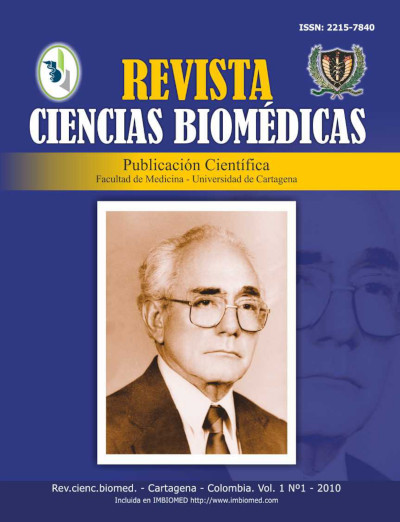El síndrome de Lambert-Eaton una sinapticopatía presináptica
El síndrome de Lambert-Eaton una sinapticopatía presináptica
Contenido principal del artículo
Resumen
Un total de cinco pacientes con diagnóstico de síndrome miasténico de Lambert-Eaton fueros estudiados utilizando técnicas electrofisiológicas. Los resultados presentados en este artículo demuestran que la patogenia del síndrome de LEMS es producida por un mecanismo autoinmune, que afecta la sinapsis neuromuscular, bloqueando a través de anticuerpos subunidades de los canales iónicos terminales axonales para el Ca2+ y alterando los mecanismos básicos de recaptación de Ach a nivel de receptores presinápticos. Rev.cienc.biomed. 2010, 1(1): 128-135.
Palabras clave
Descargas
Datos de publicación
Perfil evaluadores/as N/D
Declaraciones de autoría
- Sociedad académica
- Universidad de Cartagena
- Editorial
- Universidad de Cartagena
Detalles del artículo
Referencias (VER)
Willis T. two discourses concerning the soul of brutes de anima pordage s. (Trans), London 1683.
Lambert EH. Defects of neuromuscular transmission in syndromes other than myasthenia gravis. Ann NY acad 1959; 135:367-370/.
Lambert EH. Eaton LM, Rooke ED. Defect or neuromuscular conduction associated with malignant neoplasma. Am j Physiol 1956; 187:612-613.
Changuex Jp. The acetylcholine receptor: its molecular biology and biotechnological prospects. BioEssays 1989; 10:48-54.
Guerrero-Figueroa R. síndrome de Lambert-Eaton una alteración funcional presináptica. A propósito de tres observaciones. Medicas UIS 1988; 2: 165-171.
Elmqvist D, Lambert EH. Detailed analysis of neuromuscular transmission in a patient with the myasthenic syndrome sometimes associated with bronchogenic carcinoma. Mayo clin proc
; 43: 689-713.
Vicent A, Lang B, Newsom-Davis J. autoimmunity to the voltage gated ca2+ channel underlies the Lambert-Eaton myasthenic syndrome, a paraneoplastic disorder. Trends Neurosci 1989;
: 496-502.
Lambert EH, Elmqvist D. Quantal components of end-plate potentials in the myasthenic syndrome. Ann NY Acad Sci 1971; 183: 183-199.
Hewett Sj, Atchison WD. specificity of Lambert-Eaton myasthenic syndrome immunoglobulin for nerve terminal calcium channels. Brain Res 1992; 599: 324-332.
Lang B, Newsom-Davis J, Wray D, et al. Autoimmune etiology for myasthenic (Eaton-Lambert) syndrome. Lancet 1981; 2: 224-226.
Lang B, Newsom-Davis J, Prior C, et al. antibodies to motor nerve terminals: an electrophysiological study of a human myasthenic syndrome transferred to mouse. J Physiol 7983; 344:335-345.
Leveque c, hoshito t, David P, et al. the synaptic vesicle protein synaptotagmin associates with calcium channels and is a putative Lambert Eaton myasthenic syndrome antigen. Proc Natl Acad sci USA 1992; 89:3625-3629
Leveque C, El Far O, Martin-Moutot N, et al. purification of the N-type calcium channel associated with syntaxin and synaptotagmin. J Biol chem. 1994; 269: 6306-6312.
David P, El Far O, El Far O, Martin-Moutot N, et al. expression of synaptotagmin and syntaxin associated with N-type calcium channels in small cell lung cancer. FEBS Lett 993; 326: 135-
El Far O, Marqueze B, Leveque Ch, et al. Antiges associated with N-and L-type calcium channelsd in Lambert-Eaton myasthenic syndrome J Neurichemy 1995; 64: 1969-11702.
Hajela RK, Atchison WD. Synaptotagmin and syntaxin are not primary target of Lambert Eaton myasthenic syndrome autoantibodies. (Abstr.) Biophys J 1994; 66: A3800.
Hajela RK, Atchison WD. The proteins synaptotagmin and syntaxin are not general targets of Lambert -Eaton myasthenic syndrome autoantibody. J Neurochem 1995; 64 1245-1251.
Martin-Moutot N, Lang B, Newson-Davis J, et al. binding of Lambert-Eaton myasthenic syndrome igC to synaptosomal proteins does not correlate with an inhibition of calcium uptake. Neuroscience letters 1995; 187:115-118.
Grassi C, Magnelli V, Carabelli V, et al. inhibition of low-and high-thereshold Ca2+ channels of human neuroblastoma IMR32 cells by Lambert-Eaton myasthenic syndrome (LEMS) igGs. Neuroscience letters 1994; 11181:50-56.
Blandino JKW, Viglione MP, Bradley WA, et al. Voltage-dependent sodium channels in human small-cell lung cáncer cells: Role in action potentials and inhibition by Lambert-Eaton syndrome igG. J Membrane boil 1995; 143: 153-163.
Lennon VA, kryzer TJ, Griesmann GE, et al. calcium-channel antibodies in the Lambert-Eaton syndrome and other paraneoplastic syndromes. N Engl J Med 1995; 332: 1467.1474.



 PDF
PDF
 FLIP
FLIP





